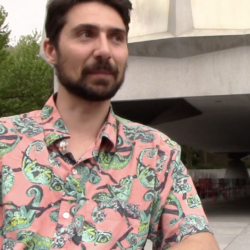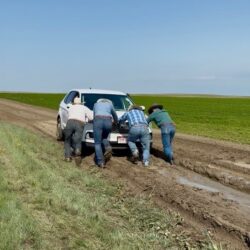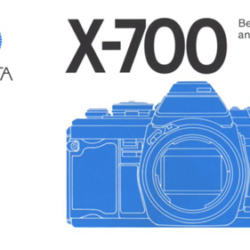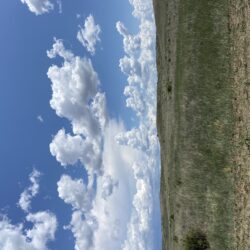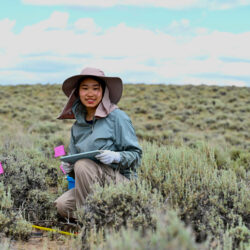Author: Madeline Gupta
The kindness of strangers in the remote open prairies—Isabella Goodman
The northern great plains aren’t the most social space, they aren’t your typical eco-tourism destination, and the vast endless wide-open space doesn’t necessarily cultivate a lot of human-to-human interactions. We sometimes go hours without seeing another car. This became apparent at the first site of my field work campaign. I am driving from southern Saskatchewan Read more about The kindness of strangers in the remote open prairies—Isabella Goodman[…]
Yarning: An Indigenous Knowledge Approach to Ethnographic Methods with Heritage Lands Collective—Carine Rofshus
My first week with Heritage Lands Collective, a non-profit organization dedicated to integrating Indigenous Knowledges (IK) into Tribal co-management of ancestral lands, was spent at the Bears Ears National Monument in southeast Utah. Bears Ears is the ancestral homelands of the Hopi, Ute, Navajo, Rio Grande Pueblos, and the Zuni. Joseph Gazing Wolf (Lakota/Amazigh/Nubian) and Read more about Yarning: An Indigenous Knowledge Approach to Ethnographic Methods with Heritage Lands Collective—Carine Rofshus[…]
Lessons from a Minolta X-700 —Alaina Geibig
My dad captured nearly my entire childhood on grainy-textured, saturated film prints. Recently, with him moving from the far side of Colorado, we endeavored to trim the photo contents of four sagging storage tubs. It was a slow task of recollection, necessitating hot tea and stories. With containers half-sorted, I noticed that the film record Read more about Lessons from a Minolta X-700 —Alaina Geibig[…]
Radiation Use Efficiency in the Western Great Plains
Aboveground net primary production (ANPP) in drylands is often estimated using the Monteith Model. This model relies on an estimation of radiation use efficiency (RUE), which is the amount of dry matter produced per unit of absorbed photosynthetically active radiation. While ANPP trends are well studied, RUE remains less explored, particularly regarding the role of Read more about Radiation Use Efficiency in the Western Great Plains[…]
Long-term Recovery of Herbaceous Production and Plant Functional Type Composition on Reclaimed Well Pads in the Jonah Field
Jianing is investigating how aboveground net primary production (ANPP) and plant functional type composition recover over time on reclaimed gas well pads and in adjacent undisturbed areas in Jonah Field. The Jonah Field, located in the Upper Green River Basin of southwestern Wyoming, is a major site of natural gas development within dryland ecosystems, where Read more about Long-term Recovery of Herbaceous Production and Plant Functional Type Composition on Reclaimed Well Pads in the Jonah Field[…]
Investigating Organic Soil Matter in the Sagebrush Ecosystem of Jonah Field, WY, Following Disturbance
Myroslav, under the mentorship of PhD candidate Damaris Chenoweth, is investigating how soil disturbances from gas development at the Jonah field affect the sagebrush ecosystem in Wyoming. His research focuses on understanding how well pad construction for hydraulic fracturing influences sagebrush regeneration— a key challenge for conservation. The project combines remote sensing and field-based methods. Read more about Investigating Organic Soil Matter in the Sagebrush Ecosystem of Jonah Field, WY, Following Disturbance[…]
2024 Annual Report
Check our UHPSI’s newly released 2024 Annual Report! Read about student projects, impacts, and journeys from the past year.
Enhancing Public Transit in Crested Butte, Colorado—Kathleen Maeder
Crested Butte, a mountain town located high in the Colorado Rockies, prides itself as a community infused with creativity, authenticity, and a deep sense of connection to the Town’s unique history and character. Yet the Town is at a crossroads: to preserve the qualities that make Crested Butte so beloved, it must reduce its car Read more about Enhancing Public Transit in Crested Butte, Colorado—Kathleen Maeder[…]
Building Bridges: Mapping Beaver Conflicts and Solutions in Montana
Effective mapping can be a crucial tool for managing human-wildlife interactions that benefit both people and nature. In partnership with the Montana Beaver Conflict Resolution Program at the National Wildlife Federation, UHPSI research assistant Xiaofan Shen is creating two interactive mapping tools to visualize beaver conflicts and highlight successful mitigation strategies across Montana. One map Read more about Building Bridges: Mapping Beaver Conflicts and Solutions in Montana[…]
Desolation Canyon—Alex Wells
Over my summer as a Western Resource Fellow with the National Forest Foundation (NFF), I spent my time diving into some of the complexities of implementing stream restoration in the West. Whether that was creating outreach materials to communicate the relevance of stream restoration to water rights holders or developing a tool for the NFF Read more about Desolation Canyon—Alex Wells[…]
The dynamics of an ending field season, why soundscape conservation matters for people and nature and unfiltered love—Joshua Kesling
The end of a field season can yield a suite of emotions. For some, the transition from field settings to temperature and humidity-controlled data organization and refinement centers (namely, our homes, offices, and corner coffee joints) brings unfettered joy. In others, the changing gears reminds us of the time we spent waist-deep in high alpine Read more about The dynamics of an ending field season, why soundscape conservation matters for people and nature and unfiltered love—Joshua Kesling[…]
Underground History Lessons in King County—Ingrid Thyr
Last weekend, I checked off one more box from my summer to-do list as I descended beneath the streets of Seattle and attended Bill Speidel’s Underground Tour. For approximately 75 minutes, I got a crash course in early Seattle history and enough musty basement air to last me for a while. And, although this adventure Read more about Underground History Lessons in King County—Ingrid Thyr[…]
The National Renewable Energy Lab
Much of my work at the National Renewable Energy Laboratory (NREL) as a mechanical engineering intern has consisted of sitting in a gray cubicle, surrounded by identical cubicles, staring at my dual monitor screens. I spend most of my working hours in SolidWorks, a computer-aided design software. Using this software, I model potential tidal turbine Read more about The National Renewable Energy Lab[…]
Why it’s Cardinal to Observe the Relationship Among Mountain Wildlife, Spatial Scales, and Ecosystem Dynamics—Joshua Kesling
Many wildlife species receive support from mountain natural areas interspersed throughout the Uinta-Wasatch-Cache National Forest. Upper elevation field sites, ranging from 6,500-8,500 ft above sea level, cover several ecoregions or ecosystems and landscapes determined by biological, geological, chemical, and physical factors. For instance, in the uplands beyond the freshwater shorelines, dense conifer forest stands (i.e., Read more about Why it’s Cardinal to Observe the Relationship Among Mountain Wildlife, Spatial Scales, and Ecosystem Dynamics—Joshua Kesling[…]

